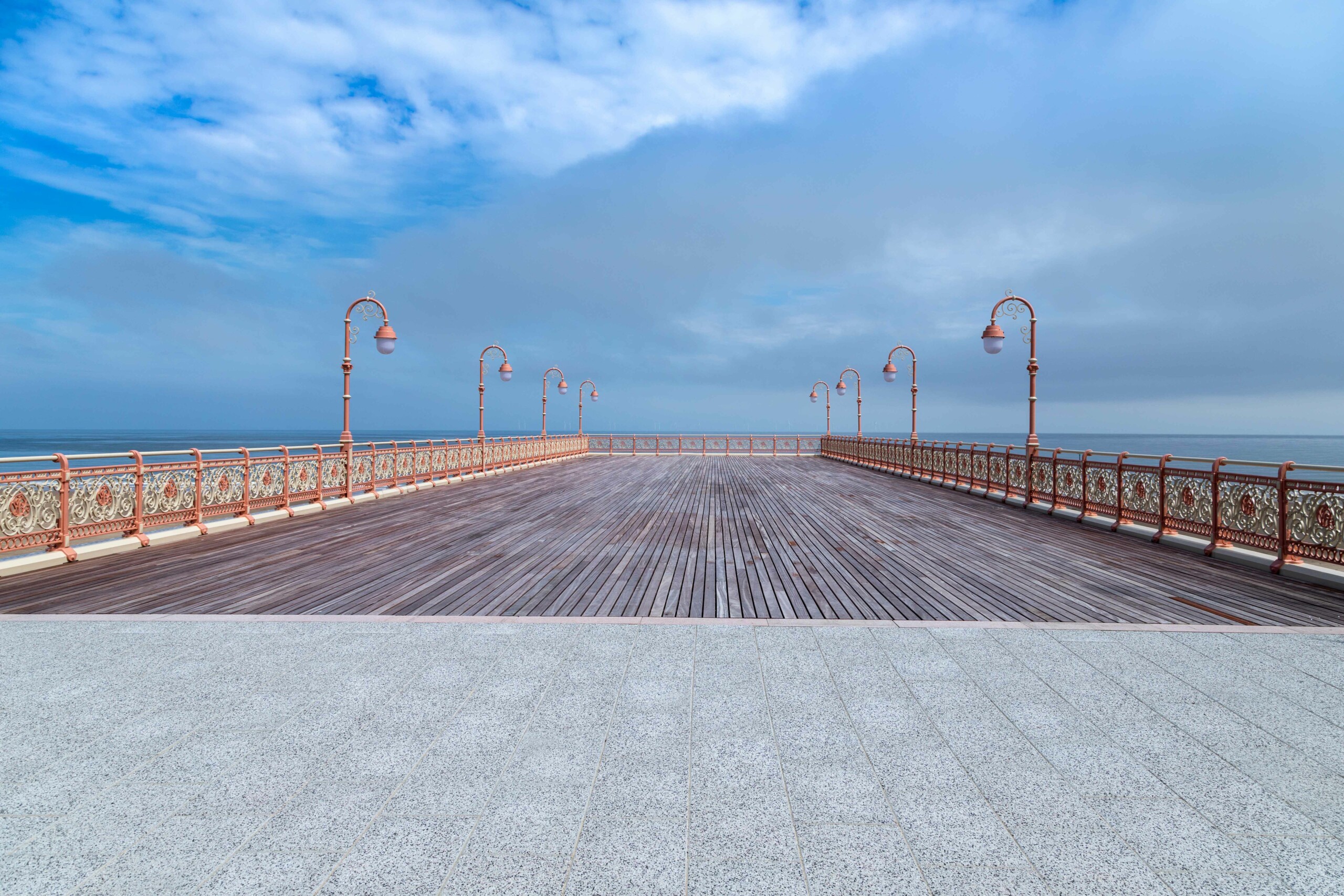Colwyn Bay’s historic Grade II listed Victoria Pier
Colwyn Bay
After a turbulent 121-year history that saw three pier complexes built – and destroyed three times by fire and, eventually, the elements – Colwyn Bay once again has a public amenity on the seaside which can be enjoyed by both residents and visitors alike. Although the most recent structure was dismantled in 2018 for safety reasons – leaving only nine standing columns and the stone seawall remaining – salvaged elements of previous piers have been retained and cleverly reimagined in a way that pays tribute to the pier’s historic fabric, setting and social significance. The commitment to secure the future of Colwyn Bay’s Victoria Pier is testament to its importance to the town.
An Important part of Colwyn Bay’s history
Since the opening of the original Victoria Pier in 1900, the structure has been a symbol of Colwyn Bay’s status as a thriving tourist destination. Over the years, the pier was extended to include the Bijou theatre and played host to entertainers ranging from Morecambe and Wise to Elvis Costello. The third and final pavilion built on the pier in 1934 was designed by Stanley Adshead in an Art Deco style, and featured murals by the renowned painter Eric Ravilious, as well as Mary Adshead – daughter of the architect and herself an accomplished artist.
A Challenging brief
Upon winning a competitive tender for the Pier in 2018, the team were faced with a structure that had severely dilapidated since its closure in 2008, been ravaged by Storm Doris in 2017 and was subsequently primarily dismantled to ensure public safety and safeguard what was left of the pier.
Insall inherited a project comprising nine standing columns, a stone seawall and numerous fragments of the previous structures which had been removed for safekeeping. With Planning and Listed Building Consents already in place to reinstate the initial three bays of the pier, their challenge was to develop the technical designs.
Given the scale of the restoration and renewal of missing elements, Insall needed to establish a strategic approach that would protect the structural integrity as well as the character of this centrepiece of Colwyn Bay’s architectural heritage.
Creative solutions
The approach involved carefully detailed research – not only into the physical condition of the fragments remaining on- and off-site, but also into the pier’s social and architectural history. The aim of this conservation project was to protect what was significant about the pier whilst allowing lessons learnt from past disasters to inform the detailing of new elements in order to better preserve the pier’s structure in the long-term.
As the harsh coastal environment had hastened the demise of previous piers, technical investigations were undertaken into the remaining cast-iron fragments. This enabled them to understand what went wrong and to ‘design out’ inherent defects – creating a structure which was both more robust and easier to maintain, whilst importantly retaining as much of the original historic fabric as possible. In order to combat the salt-water damage which had ravaged the ironwork and timbers of previous piers, Insall improved the detailing to encourage water away from the structure and chose a coating system for the original Moorish Revival cast-iron balustrades that better protects them
Research into the pier’s architectural history and social significance, as well as expert paint analysis of the 1934 structure, influenced the choice of salmon pink and cream for the decorative scheme. These colours bear a striking resemblance to colours in the interiors of the Art Deco pavilion, as well as Ravilious and Adshead’s murals, which had previously been removed for safekeeping. Almost poetically, whilst the future and conservation of the Ravilous murals remain uncertain, their spirit has been recaptured in the decorative scheme of the pier.
Armed with an understanding of the pier’s historic fabric, setting and social significance, along with a philosophy that emphasises repair over restoration, the project – led by Insall in partnership with Conwy County Borough Council – has achieved the reinstatement by retaining and repairing the pier’s nine remaining columns and the decorative cast-ironwork, and reinterpreting the lighting based on the original designs. The result is a truncated, yet elegant, pier.
